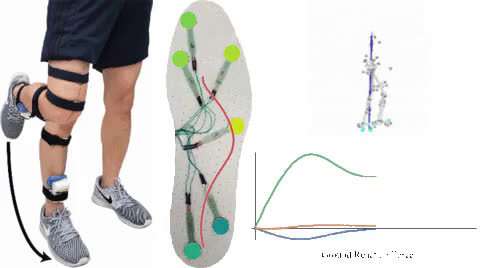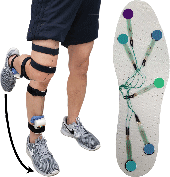Low-cost, sensor-equipped insole to monitor gait of patients with mobility impairments

An interdisciplinary team of University of Massachusetts Amherst researchers has developed a low-cost shoe insole, equipped with force-sensitive resistors (FSR), that aims to improve the management of health conditions that impair mobility, such as stroke, Parkinson's disease and osteoarthritis.
The insole "measures two important kinetic parameters that are relevant to how people walk; that is, the ground reaction force (GRF) and center of pressure (CoP)," says lead investigator Sunghoon Ivan Lee, assistant professor in the Manning College of Information and Computer Sciences. "Those parameters contain very important information, especially for people who have gait problems."
Lee's 2018 National Institutes of Health Trailblazer Award for Young Investigators helped fund the research, published recently in the journal IEEE Transactions on Biomedical Engineering and selected as a Featured Article. In addition to lead author Brandon Oubre, an information and computer sciences Ph.D. candidate, Lee collaborated with kinesiologist Katherine Boyer, a gait expert, and Ph.D. candidate Skylar Holmes, both from the School of Public Health and Health Sciences.
Information from the insole sensors could help clinicians conveniently monitor disease progression over time and make earlier interventions for people with neurological, musculoskeletal and other conditions that affect mobility.
Currently these gait parameters can only be measured in a lab with expensive scales and specialized cameras that track reflective "dots" attached to the body. "It's not easily accessible for people, especially those living in rural or underserved areas, so it's difficult to monitor how these parameters evolve throughout the course of their therapy or rehabilitation," Lee says. "And the lab environment does not really represent how they walk naturally outside of the laboratory."
The researchers' challenge was to come up with an inexpensive, wearable solution to accurately measure where the pressure is centered on the sole when a person walks.
"For healthy individuals, there's a normal way to put the pressure on the ground when you walk: You hit with the heel and then you will roll around the outer edge of your sole, then your toes will be in contact with the ground and then finally you take off," Lee says. "But these inexpensive sensors are not very accurate, that's the caveat."

So the research team built an artificial-intelligence algorithm to process the sensors' data, resulting in accurate information about the kinetic parameters. "That's the key contribution of our paper," Lee says.
The research found that the insole devices accurately estimated GRF and CoP based on models, despite the deficiencies in force sensitive resistor data.
One day, the researchers hope that insoles with sensors could be used in clinics and patients' home environments to provide real-time data about their walking gait, sent wirelessly to health care providers.
"There will be many hurdles to enable this vision, but that's the ultimate thing that we're aiming for," Lee says.
More information: Brandon Oubre et al, Estimating Ground Reaction Force and Center of Pressure Using Low-Cost Wearable Devices, IEEE Transactions on Biomedical Engineering (2021). DOI: 10.1109/TBME.2021.3120346





















